#chinese dragon tapestry
Text
where the light is dim
Pairing: Malleus Draconia x gn!reader
Synopsis: everyone's wandered off in the festival, and you can't even find a familiar face
Tags: poetic themes, fluff, diasomnia shenanigans
Word count: 436
Notes: happy chinese new year everyone🧧🏮🎆!! this was heavily inspired by a chinese poem that takes place on new years (which i attempted a translation of below hehe), and plus it's the year of the dragon, so now we have mal mal festival time ( ╹▽╹ )
Masterlist

The east wind blows breezes a thousand blossoming trees,

The stars, like rain, descend like a gentle breeze.
Bejewelled carriages and fine horses leave a fragrant trail on the road,
Phoenix flutes resound in the wind, the jade lantern’s light flows,
All night, the fish and dragon lanterns dance.
Maidens adorned with gold, extravagant pins in their hair,
Smiling shyly, fragrance lingering in the air.
In the crowd, searching countless times,
Suddenly, turning my head,
There stands the one, where the light is dim.
―青玉案・元夕 辛棄疾
The street pulses with energy, vibrant and bustling beneath a canopy of scarlet lanterns that sway gently in the evening breeze. Each lantern, adorned with intricate designs and tassels, casts a warm, inviting glow that bathes the cobblestone pavement below in a rich crimson hue.
The air is alive with the hum of chatter and laughter, as locals and visitors alike meander through the thoroughfare, their footsteps echoing against the ancient brick walls that line the street. Vendors peddle their wares from colourful stalls, their voices competing with the lively strains of traditional music that drift from nearby taverns and teahouses.
'Where is he?' you thought to yourself, tired from the heavy ornaments painstakingly styled into your hair as you turned and turned your head to catch even a glimpse of him amidst the bustling crowd.
Malleus had invited you to a short trip to the Far East, prompted by Silver's longing to explore the lands of his childhood hero, and swiftly organized by Lilia's enthusiastic urging. You're not sure whether Lilia was aware of it or not, your travels happened to coincide with a grand local festival.
The street offers a multitude of intrigue, from mouth-watering scents from the food skewers to the delicate souvenirs hand-crafted by merchants, and it's not long before you find yourselves gradually becoming separated from the group amidst the bustling crowd. The allure of the vibrant surroundings pulls each person in a different direction, until eventually, you can no longer spot any familiar faces amidst the sea of glamorous outfits adorning the local ladies.
A whirring noise catches your attention, and you turn to the direction of the sound. Your gaze is met with the spectacle of fireworks illuminating the night sky, their explosions of brilliance painting the heavens with vibrant hues, scattering glittering sparks like diamonds. Brilliant reds, dazzling blues, and alluring golds intertwine and collide, creating a breathtaking tapestry of colour that captivates all who gaze upon it.
It's a view you want to share with him.
You weave through the crowd once again, deftly sidestepping opulent carriages and elegant ladies. Their alluring perfume mingles with the joyous melodies of the flutes, enveloping you in a whirlwind of sensation that leaves you momentarily dizzy.
A glance down a narrow alley catches your attention, and in the distance, a lone lantern flickers. Squinting to sharpen your focus, you realise you've found the very person you're looking for.
Malleus, tucked away in the shadowy corner, his focus fixed solely upon a weathered lion stone statue.
You can't help the exasperated smile that graces your lips.
Maybe you should've expected that.
Masterlist

if you liked this post, don't forget to reblog!
#twstnexus#twisted wonderland#twisted wonderland x reader#twst imagines#malleus draconia#malleus draconia x reader#twisted wonderland malleus#twst malleus#twst malleus x reader#diasomnia
406 notes
·
View notes
Photo

This home in Los Osos, California is a case of rich people not knowing what kind of decor they want. Zillow calls it a “Mediterranean Castle.” Whatever. It’s $2.9M and is a study in ostentation. You’ll love it.

Firstly, I wouldn’t want to climb all these steps to get into a house, no matter how they’re illuminated.

This is outrageous. Who intentionally builds a house w/stairs like this? Where’s the mailbox?

Anyway, let’s imagine that we climbed up to the front door, I’m needing oxygen, and we’re hitting the intercom button on the right. (My house had that same intercom and it was so dated, people made fun of it.)


As soon as we enter the foyer, we can see how confused they are. There’s a big medieval soldier with a serene Zen motif, neither of which is Mediterranean.



Notice the tile work, the columns (still no Mediterranean) and the bright red carpet.

I’m so confused. The fireplace has gryphons and I thought it was Egyptian, but it’s painted bright red. I give up w/this house, already.

Persian rug, Italian or French statue.

The Buddha and a Chinese dragon, plus a statue on a Greek column that bears a resemblance to Puss in Boots. Also, more stairs just to get up to the kitchen.



The backsplash isn’t Mediterranean, or is it? I’m so confused.


The dining room. This decor is a League of Nations style.

Now, they tell me there’s an elevator.

Going down more stairs, we pass by some kind of a balcony.
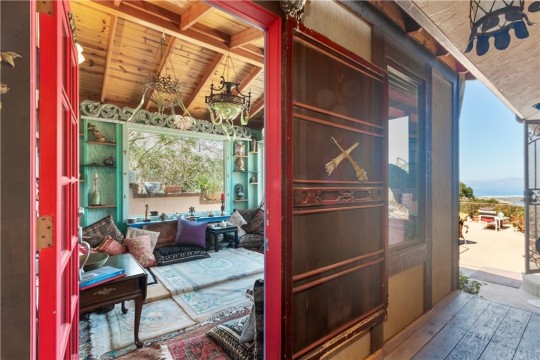
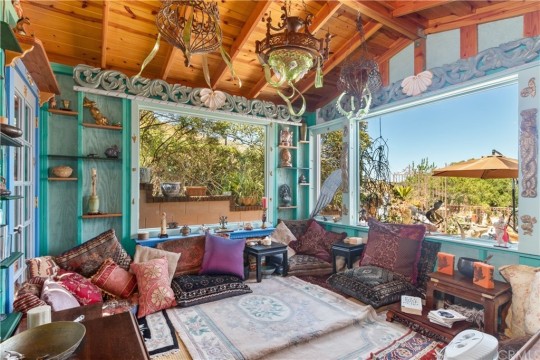
And, out to a very Zen meditation room.


I don’t think I’ve ever seen a hot tub w/so many jets. I’m afraid of it.

Here’s a bathroom- is that a horse in a coral in the ceiling light?

Look at the closet doors. Are those posters?
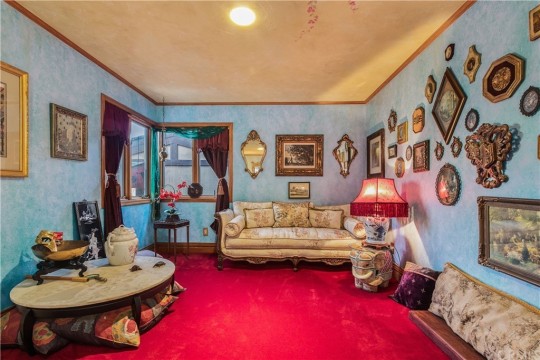
Family room, maybe?

This is the balcony we saw before. There’s a French tapestry.
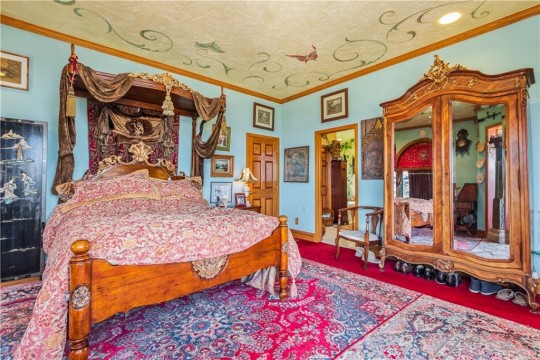

So, this would be the main bd.
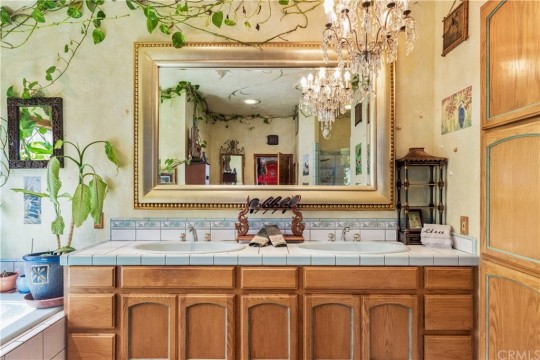

And, the en suite.

Looks like a home office.

And, a shower.


Another office? Look at this fireplace. I can’t even.

Well, right about now in the tour, I feel like I need a drink.


WTH is this?
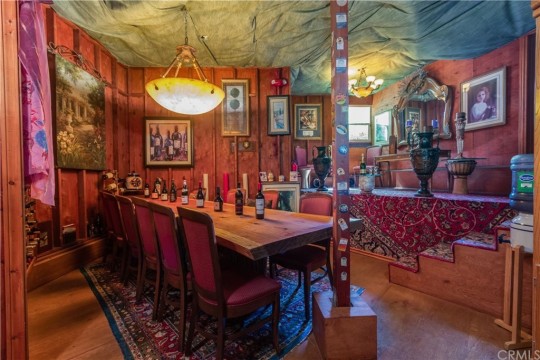
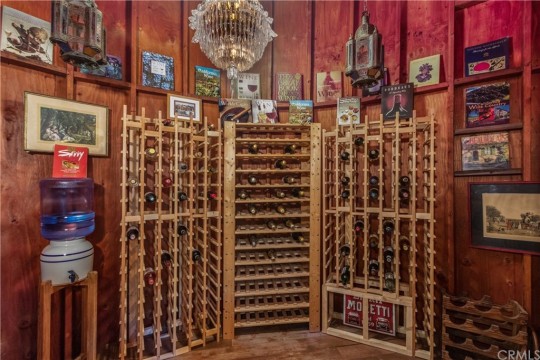
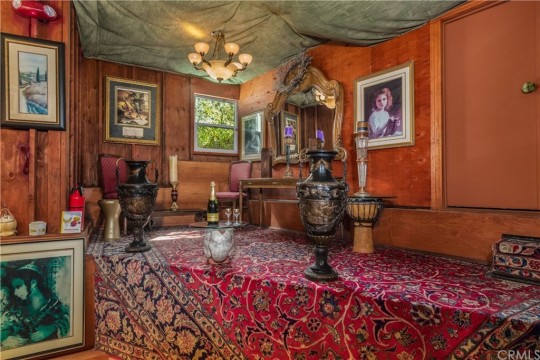
Wine room? With a stage?

Maybe a guest room.


A studio?



I guess the rough terrain doesn’t allow for a yard, so there’s a deck. I hate this house.
https://www.zillow.com/homedetails/2743-Rodman-Dr-Los-Osos-CA-93402/15447453_zpid/?
1K notes
·
View notes
Text
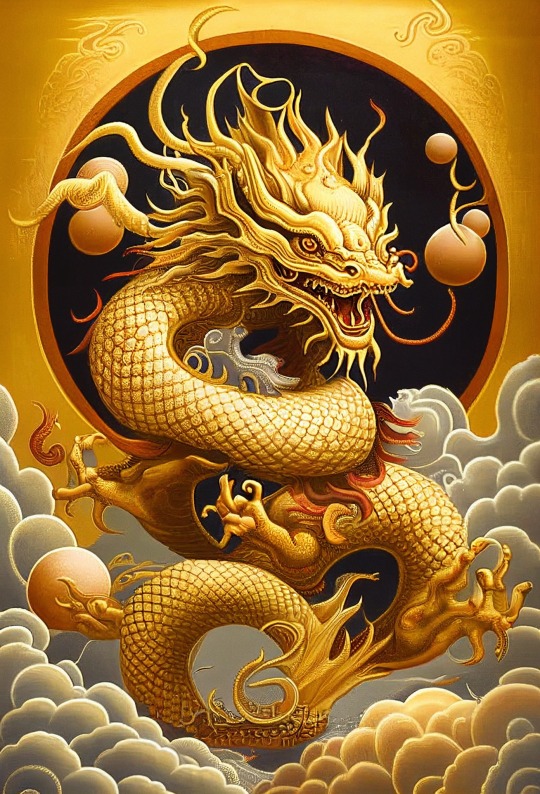
Fortune - Golden Dragon, Chinese New Year
The dragon, with its ethereal presence, is an embodiment of good fortune in Chinese culture. Believed to bring prosperity and luck, the dragon's association with wealth is deeply rooted. Its presence during festivals and celebrations is a testament to the belief that it can usher in a bountiful and prosperous future.
The Dragon Dance: A Spectacle of Fortune
The mesmerizing dragon dance during Chinese New Year symbolises the pursuit of good fortune and prosperity.
The undulating movements of the dragon are believed to disperse positive energy and attract auspicious chi.
Dragon as a Guardian: Warding off Misfortune
Statues and depictions of dragons are often placed in homes and businesses to ward off negative energies and invite good luck.
The dragon's watchful gaze is thought to protect against misfortune and obstacles.
Gold dragons were the strongest and most majestic of the metallic dragons, and were considered the apex of the draconic race. Graceful and wise, they were relentless and dedicated foes of evil, injustice, and foul play.
Golden Dragon
Talon Abraxas
29 notes
·
View notes
Text
BHS Tarot Reading - Hyunjin (Stray Kids)
BHS Game stands for Blindfold - Handcuff - Spank and it’s a more spicy variant of the Kiss - Marry - Kill game. This passive version of the BHS Tarot Game describes idols’ reactions to them being on the receiving and giving side of these activities. Depending on your preferences, you can read only the parts you personally feel drawn to or you can read it all out of curiosity. This version describes the situation from the idol’s perspective but can include some details about you, if the cards indicate it.
Disclaimer:
All celebrity readings have purely entertainment nature
I don’t know any of the celebrities personally
Don’t base life decisions purely on tarot readings
I can never guarantee any of what’s said in the reading
Feedback: Feedback is very important for content creators and for me it’s even more important. Please, let me know whether the tarot readings resonate. If there’s anything you dislike or find off about my readings (like wording, topics, focus), just tell me. I don’t want you to write 1000-word feedback, very simple comments will do for me to stay motivated. I don’t know why I have to keep repeating this but this is something I do for you, guys, and when I don’t feel motivated to do tarot readings, I have many other things to do. The more motivation I get, the more readings you will get to read. The logic is very simple but it’s two sided.
Reading Info:
Rating: 18+
Reading Type: Single - Couple
Requested: Yes - No
Requester: /
Deck(s): Erotic Fantasy Tarot, Tarot of Sexual Magic, Tarot of Casanova
Spread: BHS
Questions:
Blindfolded by you
Handcuffed by you
Spanked by you
Blindfolds you
Handcuffs you
Spanks you
Celebrity Info:
Full Name: Hwang Hyun Jin
Stage Name: Hyunjin
Group: Stray Kids
DOB: 20.03.2000
Blood Type: B
MBTI: INFP
Sun Sign: Pisces
Chinese Sign: Metal Dragon
Life Path Number: 7
Masterpost: Stray Kids

Hyunjin (Stray Kids) - Sub

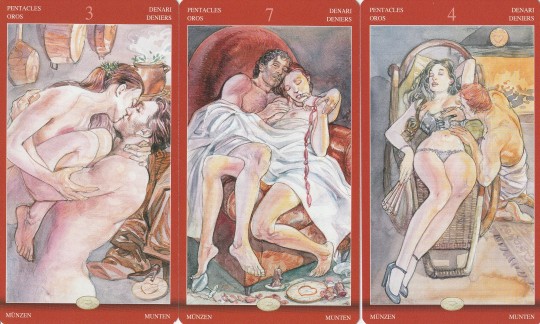
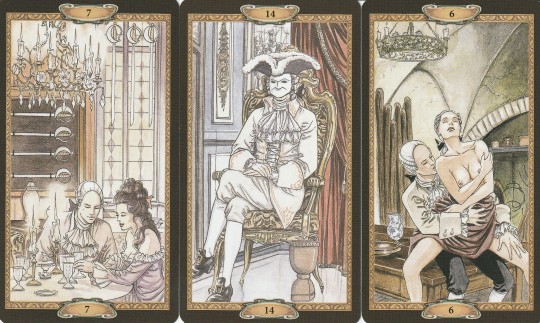
Blindfolded by you (VI The Lovers, Page of Wands, Ace of Cups - Erotic Fantasy Tarot):
Being blindfolded by you is an act of utter trust on Hyunjin’s side. He puts his entire being into your hands, trusting you that you will handle him gently. Hyunjin expresses his love and devotion in letting you take control. He’s vulnerable only for you and you have to keep in mind that if you break that trust, it’s forever and can’t be mended. There’s a sin hinted in the cards which might suggest that for Hyunjin, being blindfolded by his lover is in a way a sinful, yet pleasurable experience. It might allow him to drop any restraints he might have, speak freely, ask you to do things he would never spell out without the blindfold. With the ace of cups, he might actually love to blindly go down on you and drink you up like a fountain of youth.
Handcuffed by you (3 of Pentacles, 7 of Pentacles, 4 of Pentacles - Tarot of Sexual Magic):
It looks like for Hyunjin, handcuffing him is exactly in his comfort zone. He likes to be at your service and in your mercy. The restriction of his hands allow him to better bask in your warmth, in anything you are willing to give him. He might truly become rather passive once you tie his hands (possibly ankles) up. He’s likely to lie back, relax and only encourage your plans further. Hyunjin wants to be (wo)manhandled with care and gentleness, though. He wants to feel you whole, your limbs entwined, skin to skin. He’s into all soft, though, so make sure to use non-harmful materials. Thick velvet yarn for knitting will do and it will also appeal to Hyunjin’s aesthetic taste as you can turn him into a sort of a beautiful tapestry tying him up shibari style with soft yarn. Be sure he will insist on you taking a picture of him being an art piece. Handcuffs allow Hyunjin to pull and feel the physical restraint instead of the mental boundaries. While he’s physically limited wearing the handcuffs, his fantasy and lust can be free of any prejudice or shame. It looks like Hyunjin has some internal issues with what’s considered acceptable and it causes friction in his life. He might enjoy submitting to someone as it somewhat frees him of the responsibility. While he might be into some things, he feels guilty for those fantasies. However, if his mistress or master brings those up, he’s more than happy to participate.
Spanked by you (7 of Swords, King of Cups, 6 of Wands - Tarot of Casanova):
Once again there’s the motive of forbidden pleasure for Hyunjin. He’s likely to crave spanking once in a while but it has to be done secretly and only with a person he fully trusts. He needs to feel a deep emotional and spiritual connection with you first before he consents to a physical punishment. It’s not likely for him to act up, though, you might need to somewhat invent the misbehaviour as he’s not really bratty. The swords could indicate Hyunjin becoming quite vocal during spanking, be it moaning, begging or even encouraging you. Again, I suggest a lighter touch here as Hyunjin’s pain threshold isn’t high and he’s more of a gentle soul. He might actually prefer a little warm up before the spanking; stroking his thighs, massaging his back, kneading his but. Hyunjin is more likely to enjoy the touch of your hand rather than being spanked with a tool.
Hyunjin (Stray Kids) - Dom


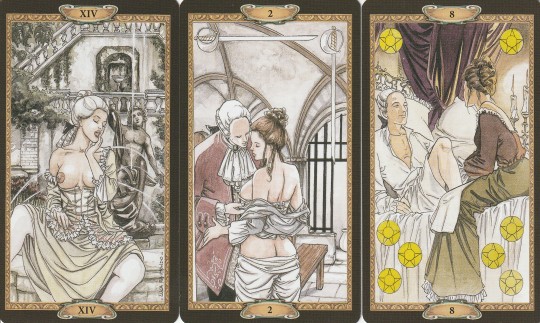
Blindfolds you (Queen of Wands, 8 of Pentacles, XVI The Tower - Erotic Fantasy Tarot):
For Hyunjin, sex is all about appreciating beauty and the mutual bond. He might want to blindfold you not only with a regular blindfold but with a beautiful silken scarf. He’s likely to turn you into an artistic masterpiece. Hyunjin is a gentle and caring lover. He’s not trying to gain power over you by taking one of your senses away, he’s merely guiding you towards empowerment of your other senses. Hyunjin is likely to treat you with kindness even and especially when you are at his mercy. He’s likely to actually ask you what it is you want him to do. While he has no problem doing whatever feels comfortable for you, he’s not that much of a dom to actually decide himself. He’s not the type to surprise and shock you, he always suggests or simply asks about your preferences. His own taste knows no limits as he’s simply in love with you and you are the very epitome of beauty for him, the deity he worships. If you ask him to blindfold you but then just hold you in his arms, he will do so with pleasure.
Handcuffs you (III The Empress, Page of Pentacles, 3 of Cups - Tarot of Sexual Magic):
Once again, it’s more likely to be you, who suggests to Hyunjin to handcuff you. He’s not much likely to pitch the idea himself. He might imagine it frequently but he’s not the type to share, unless you open the topic. And again, Hyunjin is likely to be super gentle and soft when it comes to handcuffing you. Don’t expect him to put metal or hard plastic handcuffs, those could harm the wrists of your which he worships so dearly. He’s likely to use the plush handcuffs or to tie your wrists with a silken or satin scarf. Hyunjin is not likely to spend much time with it either. Hyunjin likes the soft materials as we have mentioned and he will be more than happy to tie you up with colourful velvet yarns. He’s not a full shibari enthusiast, though he might copy the patterns with softer material; he will use as little material to restrain you as possible. You might actually struggle more to stop yourself from tearing the ties than with freeing yourself. And again, Hyunjin will keep asking and approach this as a teamwork. Nothing happens without your consent. His ideas might even be a little conservative at the beginning and you might need to help him open up about the more daring fantasies. On the other hand, he might actually want to take pictures of you in the vulnerable position and make paintings later on just to depict you as a real art piece. Don’t be surprised if Hyunjin has a secret locked up gallery of paintings depicting his exes in erotic poses.
Spanks you (XIV Temperance, 2 of Swords, 8 of Pentacles - Tarot of Casanova):
Hyunjin might actually be pretty hesitant when it comes to spanking you. He’s surely not the one to come up with the idea. You might need to persuade him to go for it and even so he’s really gentle because he believes he’s supposed to pleasure you, not punish you. Nothing you can do is worth a punishment in his eyes. You might really need to convince him that the spanking is for your pleasure, too. It’s likely to be more of an enlightening experience, with Hyunjin starting off with nearly featherlike touches and you begging him to put some force into it. The cards suggest, Hyunjin is not a great fan of this one in particular. While he might enjoy you spanking him, he’s not really ready to actually return the favour as the fear of harming is greater than anything else. He’s likely to opt for massaging you, kissing your but cheeks and even fingering you to make it up for you.
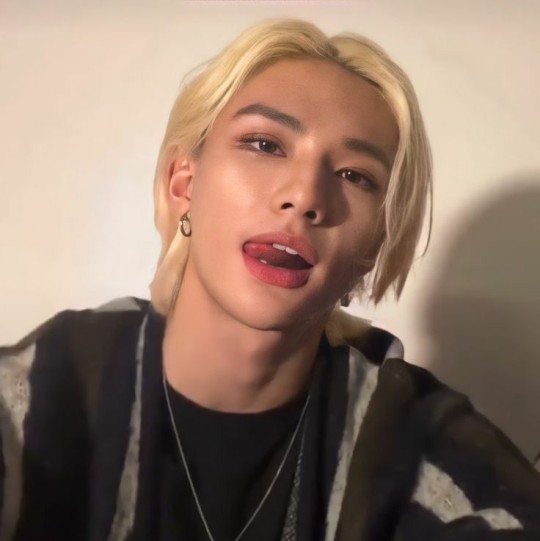
I have done this same type of tarot reading for Bang Chan already and it can be purchased on my ko-fi shop.
You can have a sneak peek of the cards here.
And yes, the plan is to do the readings for all of the members. Hyunjin's reading is here for free but the rest will follow the Bang Chan's example and they will be available in my shop.
Do you feel uncomfortable reblogging my content and you don't have the funds to support me financially through ko-fi? You can still show you appreciate my works and Czech and Slovakian shelter dogs. Click on the link bellow and the button. It's free! You can click every day! Your clicks will transform into Brit dog food every month and go to doggies in need.
CLICK AND FEED SHELTER DOGS
Have good karma and you will meet your Special Person!
Thank you for reading!
Hit the Like 💖
Comment! 💬
Reblog! 🔁
Follow for more! 💌
Any Feedback is Welcomed ✅
Consider supporting me on ko-fi 💖
Check out my k-pop and astrology themed activity book for adults - HERE! 📘
#stray kids#skz smut#hwang hyunjin smut#hyunjin smut#skz hyunjin smut#kpop#kpop smut#stray kids imagines#skz#skz imagines#kpop tarot#skz tarot#stray kids tarot#stray kids hyunjin#stray kids hyunjin smut#stray kids hyunjin scenarios#skz hyunjin#skz hyunjin scenarios#skz hyunjin imagines#skz hwang hyunjin#hyunjin stray kids#hyunjin stray kids smut#hyunjin scenarios#hyunjin imagines#hwang hyunjin#hwang hyunjin scenarios#oracle kleo
42 notes
·
View notes
Text
About Chinese Dragon Mythos
While looking up myths and folklore about dragons with fur and/or feathered wings, I came across these texts. I happen to be fluent in both scripts of the Chinese language and was able to pull information up to share these with.
DISCLAIMER: I'm just looking up old Chinese writings and translating them, in no way, shape, or form do I believe they are the gospel. I will eat anyone that tells anyone they are not dragons for being different than their ideal concept of dragons.
In <Compoendium of Materia Medica : Winged>(1)
"龙者鳞虫之长。王符言其形有九似:头似驼,角似鹿,眼似兔,耳似牛,项似蛇,腹似蜃,鳞似鲤,爪似鹰,掌似虎,是也。其背有八十一鳞,具九九阳数。其声如戛铜盘。口旁有须髯,颔下有明珠,喉下有逆鳞。头上有博山,又名尺木,龙无尺木不能升天。呵气成云,既能变水,又能变火。"
Translation available with my edits/addons in brackets
The dragon is the king of reptiles, Wangfu say it is similar to the nine animals: Head like a camel, the horns of a deer, the eyes of a rabbit, ears like cattle, [snake-like neck], belly like clam, the scales of a carp, the claws of a hawk, the palm of a tiger. There are 81 scales on the back[, which is a positive number of 9x9(2)]. Sound is like beating gongs. A beard near the mouth, a pearl on chin, [inverted scale] under the neck. [On the dragon's forehead there is a shape like Mount Bo(3), also called chǐ mù(4), without chǐ mù, a dragon cannot fly. It's breath becomes clouds], It can produce water, and it also generates fire.
- from https://www.quora.com/What-is-the-origin-of-the-dragon-in-Chinese-mythology?share=1
On Responsive Dragon/Ying long 應龍
As documented in “Tales of strange matters” (shuyiji) “horned dragon in 500 years, a thousand, and they become yonglong” it is a pinnacle of “(shape)shift dragon”, therefore it grew wings.
It served under the yellow emperor, and during the event of The Great Yu Subdue the Flood, the yinglong, with one great sweep of its tail, redirect and created a new river. This divine dragon is also named yellow dragon, yellow dragon is yinglong. Yinglong has feature of born with a pair of wings, scaled body spiked spine, large and long head, lip, nose, eyes, ears are all small, large eye frame, high eyebrow, sharp teeth, protrude forehead, thin neck large belly, long tail, four strong limbs, as if a winged alligator.
You can often see depictions of yinglong on Warring State era jade sculptures, Han dynasty's stone sculptures, tapestry, and painted utensils. "Dragon has nine hatchlings, every one of them unique." In ancient times, nine is an extremely high number, in here, it is not the exact number. It is a representation that the divine dragon has many children. And in the early era, the divine dragon also includes zhulong (candle dragon), goulong (hook dragon), kuilong, and there are also the four spirits.
On Blue Dragon/Qing Long 青龍
《张果星经》云:“又有辅翼,则为真龙”,认为有翼方是真龙。如西周有大量身负羽翼龙纹器皿,乃至青龙在先秦纹饰中也有羽翼,一说青龙为祖龙。封建时代,龙是皇权的象征,皇宫使用器物也以龙为装饰。
<Zhang Guo Star Sutra> spoke of "with the attachment of wings, it is a true dragon". It sees that a dragon with wings is a true dragon. The Western Zhou dynasty have a great number of utensils and containers that have depictions of loong with feathered wings painted on them. There is a saying that the blue loong is the ancestor dragon. In the ancient Chinese feudal era, the dragon is a symbol for imperial power. Within the palace, utensils and containers are decorated with dragons
Ben Cao Gang Mu (《本草纲目》 (Compendium of Materia Medica)) is the most complete and comprehensive medical book ever written in the history of traditional Chinese medicine. Compiled and written by LI Shi-zhen (1518~1593), a medical expert of the Ming Dynasty (1368-1644) over a period of 27 years. The first draft was completed in 1578 when Ming China was at its imperial heyday https://en.unesco.org/silkroad/silk-road-themes/documentary-heritage/ben-cao-gang-mu-bencaogangmu-compendium-materia-medica
9 is a lucky number for the Chinese, due to its sharing tone with "long-lasting", and being the biggest number before it is reset (from 9 to 10).
Mount Bo, boshan. I believe it is specifically talking about this mountain in China and its unique protrusion shape.
chǐ mù, literal translation "ruler wood". I could not find a actual translation of the word
Another translation/review of the text sample is available here
Elements of culture in Ch’ing Dynasty: the Australian Museum Collection
(with some supplementary material)
By Baohua Li, Yikun Li
#chinese dragon#ancient chinese#Dream Dragon Posting#translation#dragon mythology#draconic#dragonkin#dragonkind#draconity#alterhuman#other+#alterbeing
70 notes
·
View notes
Text

2024 is the Year of the Dragon on the Chinese Calendar
Chinese New Year 2024, also known as the Spring Festival or Lunar New Year, marks the beginning of the Year of the Dragon according to the Chinese zodiac. This vibrant and culturally significant celebration, observed by millions around the world, will be a time of joy, family reunions, and traditional customs. Colorful parades, dragon and lion dances, and spectacular fireworks will light up the streets as people welcome the new lunar year with enthusiasm. Families will gather to share special meals and exchange red envelopes (hongbao) for good luck, and temples will be bustling with worshippers offering prayers for a prosperous year ahead. It's a time when the rich tapestry of Chinese culture is beautifully displayed, promoting unity, happiness, and a fresh start for all.
Learn how to draw a chinese new year dragon
#chinese new year#year of the dragon#lunar new year#dragon#chinese dragon#dragon drawing#chinese new year 2024
3 notes
·
View notes
Text
The Best Time to Visit Hong Kong: A Comprehensive Guide
Hong Kong, with its towering skyscrapers, bustling streets, and vibrant culture, is a city that captivates travelers year-round. However, choosing the optimal time to visit can greatly enhance your experience and ensure you make the most of what this dynamic destination has to offer. Here's a comprehensive guide to help you decide the best time to visit Hong Kong:
1. Weather Considerations:
Spring (March to May): Spring brings mild temperatures and blooming flora to Hong Kong. It's an ideal time for outdoor activities such as hiking, exploring parks, and enjoying the city's scenic views.
Summer (June to August): Hong Kong summers are hot and humid, with temperatures often soaring above 30°C (86°F). While it's not the most comfortable time to visit, summer is perfect for beach lovers and water sports enthusiasts.
Autumn (September to November): With clear skies and pleasant temperatures, autumn is arguably the best time to visit Hong Kong. It's perfect for sightseeing, attending festivals, and sampling seasonal delicacies.
Winter (December to February): Hong Kong's winters are mild and relatively dry, making it an attractive option for travelers looking to escape colder climates. The city is adorned with festive decorations during the holiday season, adding to its charm.
2. Festivals and Events:
Chinese New Year: Celebrated in January or February, Chinese New Year is one of Hong Kong's most significant festivals. The city comes alive with colorful parades, traditional performances, and dazzling fireworks displays.
Spring Lantern Festival: Held in conjunction with the Chinese New Year, the Spring Lantern Festival takes place on the fifteenth day of the first lunar month. Visitors can admire beautifully crafted lanterns and participate in various cultural activities.
Hong Kong Arts Festival: Taking place from February to March, the Hong Kong Arts Festival showcases a diverse range of performances, including music, dance, theater, and visual arts.
Dragon Boat Festival: Celebrated in June, the Dragon Boat Festival features exhilarating dragon boat races, traditional ceremonies, and delicious rice dumplings known as zongzi.
3. Peak Tourist Seasons:
Golden Week: The first week of October sees an influx of tourists from mainland China due to the National Day holiday. Accommodation prices tend to surge during this period, so it's advisable to book well in advance.
Christmas and New Year: Hong Kong is a popular destination for holidaymakers during the festive season. Hotels and attractions may be crowded, but the city's festive atmosphere is truly magical.
4. Considerations for Budget Travelers:
Off-Peak Travel: Visiting Hong Kong during the shoulder seasons (spring and autumn) can offer significant savings on accommodation and flights while still enjoying favorable weather and fewer crowds.
Midweek Stays: Opting for midweek travel instead of weekends can also result in lower hotel rates and dining expenses.
In conclusion, the best time to visit Hong Kong ultimately depends on your preferences, budget, and the experiences you wish to have. Whether you're drawn to the city's cultural festivities, outdoor adventures, or culinary delights, Hong Kong promises an unforgettable journey regardless of the season. So, pack your bags and get ready to immerse yourself in the enchanting tapestry of sights, sounds, and flavors that define this cosmopolitan metropolis.

3 notes
·
View notes
Text

May the Year be filled with an abundance of prosperity & fulfillment whenever you go!
There is nothing more than to celebrate the Chinese new year by wearing red, making loud noises, lighting up the firecrackers as well hanging up lanterns and putting up paper dragons but not just to rid of Nian, but coming one together for another with family. It is also a celebration of diversity, unity, and the rich tapestry of cultural influences that define the nation... 🎆🎇🎆
🎇🧧🐀🐂🐆🐇🐉🐍🐎🐑🐒🐓🐕🐖🧧🎇
#art#fanart#pj masks#pj masks an yu#happy chinese new year#chinese new year#year of the dragon#chinese zodiac animals
6 notes
·
View notes
Text
INDONESIA
Indonesia, located in Southeast Asia, is an archipelago nation comprising thousands of islands. It is a country known for its remarkable diversity, ranging from its people, culture, landscapes, to its vibrant wildlife. With a population of over 270 million, Indonesia is the world's fourth-most populous country. Let's delve into the rich tapestry of Indonesia and explore what makes it a truly unique and fascinating nation.
Cultural Melting Pot: Indonesia is a melting pot of diverse cultures, with more than 300 distinct ethnic groups inhabiting the archipelago. The country's cultural heritage is influenced by various civilizations, including indigenous tribes, Indian, Chinese, Arab, and European traders. Each ethnic group has its own language, customs, traditional clothing, and art forms, which contribute to Indonesia's vibrant cultural tapestry.
Rich Traditions and Festivals: Indonesia's cultural richness is showcased through its numerous traditional festivals. For example, during the colorful Hindu festival of Nyepi, also known as the "Day of Silence," the entire island of Bali comes to a complete standstill. On this day, people reflect, fast, and observe silence to purify the mind and soul. Similarly, the Javanese celebrate the ancient tradition of Gamelan music, accompanied by traditional dances, such as the enchanting Ramayana ballet.
Pristine Natural Beauty: Indonesia boasts a breathtaking array of natural wonders, from pristine beaches and turquoise waters to lush rainforests and towering volcanoes. Bali's picturesque landscapes, including iconic rice terraces and stunning sunsets, attract millions of visitors every year. The UNESCO World Heritage Site of Komodo National Park is home to the famous Komodo dragons, the world's largest lizards. Moreover, the captivating beauty of Raja Ampat's marine biodiversity offers exceptional diving and snorkeling experiences.
Flavors of Indonesian Cuisine: Indonesian cuisine is renowned for its unique blend of flavors, influenced by Indian, Chinese, Middle Eastern, and European culinary traditions. From the spicy and aromatic rendang, a slow-cooked beef dish, to the beloved nasi goreng, Indonesia's national fried rice, the country's cuisine tantalizes taste buds with its diverse range of spices, herbs, and fresh ingredients.
Warm Hospitality: Indonesians are known for their warm hospitality and friendly nature. Visitors to the country often experience the "gotong royong" spirit, which promotes cooperation and mutual assistance within communities. Whether it's offering a smile or sharing a meal, Indonesians welcome guests with open arms, making visitors feel at home in this culturally rich nation.
Conclusion: Indonesia is a captivating destination that offers a unique blend of cultural diversity, natural wonders, and warm hospitality. From exploring ancient temples and vibrant markets to diving in world-renowned marine ecosystems, Indonesia has something to offer every traveler. By embracing its rich heritage and preserving its stunning landscapes, Indonesia continues to captivate the hearts of those who seek adventure, cultural immersion, and natural beauty.
5 notes
·
View notes
Text
Exploring the Rich Tapestry of Chinese Cinema: A Glance at Popular Movies, Filmmakers, and Cultural Significance
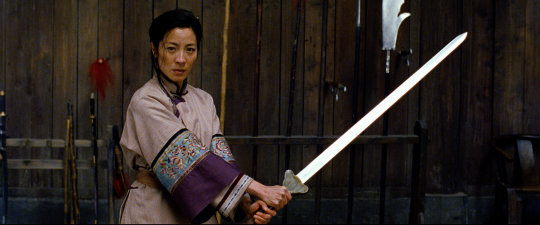
Introduction:
Chinese cinema has emerged as a powerful force on the global stage, captivating audiences with its unique storytelling, rich cultural heritage, and visually stunning films. From critically acclaimed blockbusters to intimate arthouse creations, China has produced a wide array of cinematic gems that have left an indelible mark on the industry. In this article, we will delve into the realm of Chinese cinema, exploring popular movies, celebrated actors and directors, popular genres, and the unique culture of movie watching in China.
Popular Movies from China:
"Crouching Tiger, Hidden Dragon" (2000) - Directed by Ang Lee, this martial arts masterpiece captured the hearts of both domestic and international audiences, winning four Academy Awards and becoming a global sensation.
"Hero" (2002) - Directed by Zhang Yimou, this visually mesmerizing wuxia film starred Jet Li and showcased breathtaking cinematography, intricate storytelling, and a deep exploration of Chinese philosophy.
"Raise the Red Lantern" (1991) - Directed by Zhang Yimou, this art film offers a captivating glimpse into the lives of concubines in 1920s China, showcasing the director's keen eye for visual storytelling and complex narratives.
"Farewell My Concubine" (1993) - Directed by Chen Kaige, this epic drama explores the lives of two Peking opera performers amidst the backdrop of China's turbulent history, delving into themes of love, loyalty, and identity.
"House of Flying Daggers" (2004) - Directed by Zhang Yimou, this visually stunning martial arts film combines breathtaking action sequences with a passionate love story, creating an unforgettable cinematic experience.
Well-known Actors, Directors, and Filmmakers:
Zhang Yimou - Known for his visually stunning films, Zhang Yimou is a renowned director whose works often explore themes of Chinese history, culture, and society. His films have received critical acclaim worldwide.
Ang Lee - Taiwanese-born Ang Lee has directed films both in China and Hollywood, displaying versatility in his storytelling. His ability to bridge cultural gaps has earned him numerous accolades, including two Academy Awards for Best Director.
Chen Kaige - A prominent figure in the Fifth Generation of Chinese filmmakers, Chen Kaige has crafted powerful films exploring Chinese history and society. His works often delve into the complexities of human emotions and relationships.
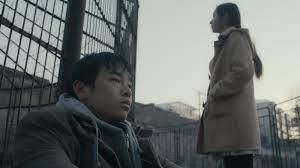
Popular Genres in China:
Wuxia: Wuxia films are characterized by their stylized martial arts action, often set in ancient China and influenced by Chinese folklore and literature. These movies blend action, romance, and fantasy elements, captivating audiences with their dynamic choreography and elaborate storytelling.
Historical Epics: Chinese cinema frequently explores historical periods, bringing to life important events, figures, and stories from China's rich past. These films delve into themes of honor, loyalty, and the struggle for power, immersing viewers in captivating historical narratives.
Contemporary Dramas: Reflecting modern Chinese society, contemporary dramas tackle social issues, family dynamics, and personal relationships. These films often offer nuanced insights into the challenges faced by individuals in a rapidly changing society.
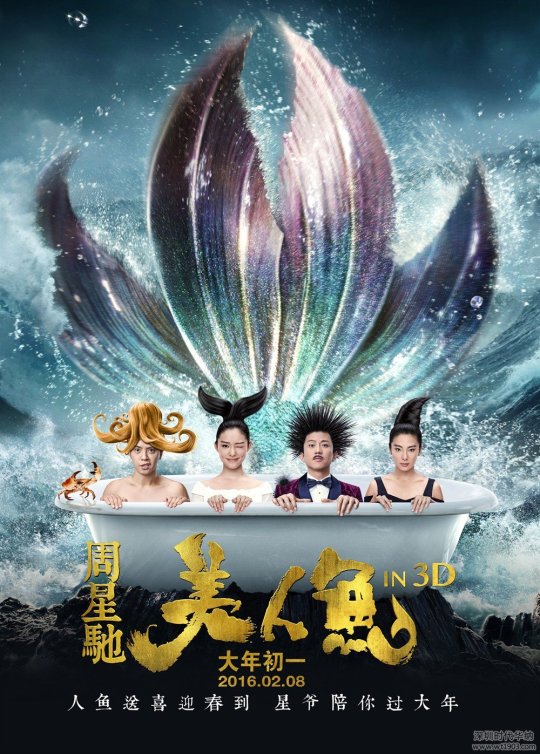
The Culture of Movie Watching in China:
Movie watching holds a significant place in Chinese culture. Cinemas are popular gathering spots, providing a communal experience for friends and families. Chinese audiences are enthusiastic, often expressing their emotions freely during screenings. The box office success of a movie is an important indicator of its popularity, with high-grossing films often seen as a reflection of public taste.
Conclusion:
Chinese cinema has grown by leaps and bounds, establishing itself as a global powerhouse with its diverse range of movies, talented filmmakers, and iconic actors. From captivating historical epics to visually stunning martial arts films and thought-provoking dramas, Chinese cinema offers a plethora of choices for audiences seeking compelling storytelling and unique cultural perspectives.
The success and popularity of Chinese cinema can be attributed to the visionary directors who have left an indelible mark on the industry. Filmmakers like Zhang Yimou, Ang Lee, and Chen Kaige have showcased their immense talent in bringing Chinese stories to life on the silver screen. Their ability to blend artistic visuals, emotional depth, and cultural nuances has garnered international acclaim, paving the way for a broader appreciation of Chinese films.
In addition to acclaimed directors, Chinese cinema boasts a roster of talented actors who have gained recognition both within China and on the global stage. Stars such as Gong Li, Zhang Ziyi, Andy Lau, and Donnie Yen have captivated audiences with their exceptional performances, adding depth and authenticity to the characters they portray.
Chinese audiences take great pride in their cinema, and movie watching has become an integral part of the country's cultural fabric. Cinemas are social spaces where friends and families gather to enjoy a shared experience. The enthusiasm of the audience is palpable, with laughter, gasps, and applause resonating throughout screenings. The box office success of a film is not only a reflection of its quality but also an indication of its resonance with the public.
In conclusion, Chinese cinema has emerged as a dynamic force in the global film industry, captivating audiences with its diverse range of movies, celebrated filmmakers, and talented actors. From historical epics to contemporary dramas, Chinese films offer a rich tapestry of storytelling, cultural insights, and visual splendor. As the industry continues to evolve, Chinese cinema will undoubtedly leave an enduring impact on the art of filmmaking worldwide.
4 notes
·
View notes
Text
The Magic of Synesthesia
Greetings, fellow magical explorers! Today, let's delve into the fascinating realm of synesthesia—an extraordinary blending of the senses that grants Fizzle Synesthetes a wondrous and multisensory experience of the magical world.

Synesthesia is a phenomenon where the stimulation of one sense simultaneously triggers sensations in different senses. Fizzle Synesthetes possess the remarkable ability to hear colors, feel sounds, and taste shapes, among an array of other intriguing combinations. It's a magical tapestry where the senses intertwine and create a vibrant symphony of perception.
The magic gene, the very essence that enables wizards to sense and utilize magic, plays a crucial role in understanding how synesthesia impacts the world of magic. While some individuals may be "blind" to the presence of magic due to lacking this gene, wizards with synesthesia possess an enhanced sensitivity to magical traces. They may perceive remnants of ancient magic, witnessing its vivid hues, shapes, and even detecting its distinct scents or melodies. Their magical sight paints the world in a colorful and captivating palette, unveiling a vibrant tapestry that transcends ordinary perception.
Beyond the sensory spectacle, synesthetic wizards possess a profound understanding of when to employ specific spells. Their synesthetic experiences serve as guiding principles, allowing them to intuitively select spells based on their visual, olfactory, or auditory qualities. They can justify using a spell that manifests as circles to counteract a square-shaped spell, or deploy a delightful fragrance-infused enchantment to neutralize an unpleasant odor. However, it's important to note that certain spells may require precise countermeasures or specialized techniques, and synesthesia doesn't guarantee a universal solution for every magical challenge.
The magic wielded by synesthetic wizards possesses a delightful eccentricity. Their spells may be accompanied by melodious tunes, captivating perfumes, or mesmerizing shapes, creating a truly immersive and sensorial experience. For instance, a basic magic missile might manifest as a majestic Chinese dragon, its roar resonating with the sheer power of the spell. Such manifestations are not indicative of the spell's potency, but rather add an enchanting and personal touch to its expression. While regular wizards can also infuse their magic with similar effects, it requires greater focus and concentration, potentially weakening the spell. Synesthetic wizards, on the other hand, effortlessly weave these sensory elements into their magic, without compromising its strength or efficacy.

2 notes
·
View notes
Note
"If you flaunt your wealth too much, people might rob you. Or they might get envious, come after you with pitchforks and guillotines. Or worse–taxation!"
Pyro let his eyes wander around Sebastian’s study while Shaw droned on. On the desk, an open bottle of wine that Sebastian had not bothered to offer to Pyro, despite his pretentions of being a polite gentleman, label reading Domaine Leroy Chambertin Grand Cru. One wall was entirely lined with shelves of whiskey, both Sebastian’s own Krakoan brand, and fine brands collected from around the world. Another shelf held a display of glittering Faberge eggs that Pyro imagined hurling across the room like the world’s most expensive grenades. There was a suit of armor in one corner, and an antique globe, the kind set inside a massive polished wooden floor-stand, in another corner. And knowing Sebastian, those were both genuine antiques, not recreations.
“Are you listening to me, Allerdyce? I am trying to give you valuable advice on how to properly spend the riches that you have somehow stumbled into. I can’t fathom why this self-indulgent drivel that you co-wrote with my son has become so popular, but you might as well actually properly invest the funds instead of pissing them away like so many new-money idiots do.”
“Why? You clearly don’t much like me, Shaw, and the feeling is mutual. Why bother giving advice?” Pyro asked, still looking at the exquisitely woven tapestry that draped across half the far wall, the bear-skin rug in front of the fire-place. Poor bear.
“Because you actually know the value of a day’s work, Allerdyce. And unlike my son, you might have a chance of using your money sensibly, assuming you can resist the lure of Vegas, fancy cars and drugs. I admit, I don’t have high hopes, but I do have some small hope for you. And let me tell you, buying a party castle in Europe is not a sensible use of your money. You’re too flashy, you have to be subtle.”
Pyro finally turned to look at Sebastian, across the desk topped with an intricately carved jade paperweight in the shape of a Chinese dragon, and a gold quill-holder molded into the shape of two ancient Greek wrestlers. Diamonds gleamed in his cufflinks and tie-clip.
“Right, Shaw, I certainly wouldn’t want to flaunt my wealth, would I?”
OOC – This is once again playing with the idea that Pyro “helped” (meaning did ALL the writing) Shinobi with a series of supernatural romance/adventure books based on an obvious self-insert. They will be making millions when the Netflix series comes out. Pyro would absolutely buy a party castle if he could. I head-canon that he actually loves old historical stuff, he writes gothic romance after all. He probably starts kicking guests out if they trash the place. “No, don’t carve your name in the walls, this is from the 14th century for fucks sake!”
Pyro will also absolutely include a scene like this in a later book, where the cruel, rich, hedonistic and hypocritical villain Bastian Claw lectures his son on not misusing his riches.
4 notes
·
View notes
Note
Tacky decorations and drawings are something else lmao
I was looking up some Chinese dragon designs and found those
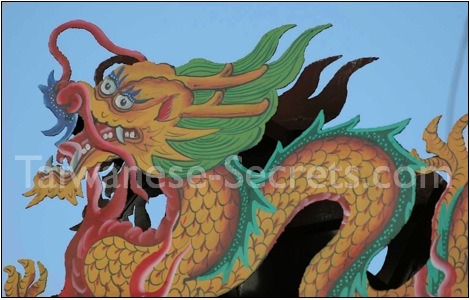

I wonder if people in liyue have similar things to sell, wether it be a painting or some part of decoration
The designs
It doesn't look glorious at all xd
Also, rex lapis depicted like this, can you imagine
It reminds me of that painting "yes, of course, I have seen a horse before"

hahahahhahhah omg i know they look so derpy.... i remember the last time me and my siblings had this little project of painting a dragon on a huge slab of styrofoam, we were looking up references and my brother (who was, at that time, studying to be a graphic designer) was just loSING IT over the derpy looking dragons lmao
pretty sure there are weird looking morax statues and paintings being sold in liyue markets. there has to be. i mean just look at the aranara statue from the current special even quest-
please, can you imagine zhongli with a s/o who LOVES these kind of tacky designs tho??? he's touched that you would buy so many figures and paintings and sewn embroidered tapestries of him, but could you at least chose those with more.... ahem.... refined.... craftsmanship.....? guests who entered your abode are almost always scared off by the huge badly sewn dragon hanging on the wall...
also fucking hell that horse(?????) looks high as fuck- you alright there bud
3 notes
·
View notes
Note
What style of dragon really tickles your fancy these days? Four leggies and wings? Classic wyvern? Flying noodle? Cat dragon?
Good question!
Although I love all styles of dragons, Chinese dragons will always have a special place in my heart ♥ I love how intricate and flowy their designs can be, and all the possible color combinations! I used to collect figurines of them, brought back as souvenirs from summer trips c:
I'm not sure where most of my collection is at the moment-- somewhere safe in storage hopefully-- but this one I kept out, it was always my favorite:

Then of course there’s this tapestry I’ve had since my high school days. It’s changed spots a few times and been chewed by a parrot I once fostered; but it’s permanent home is now behind my couch (covering two old movie posters I don’t have the heart to take down and store lol):

4 notes
·
View notes
Text
Interview with Alice Poon, author of Tales of Ming Courtesans
New Post has been published on https://china-underground.com/2020/04/30/interview-with-alice-poon-author-of-tales-of-ming-courtesans/
Interview with Alice Poon, author of Tales of Ming Courtesans
Born and raised in Hong Kong, Alice Poon steeped herself in Chinese poetry and history, Jin Yong’s martial arts novels, and English Literature in her school days.
This early immersion has inspired her creative writing. Always fascinated with iconic but unsung women in Chinese history and legends, she cherishes a dream of bringing them to the page. She is the author of The Green Phoenix and the bestselling and award-winning non-fiction title Land and the Ruling Class in Hong Kong. She now lives in Vancouver, Canada and devotes her time to writing historical Chinese fiction.
Official Site | Instagram | Twitter
Where does the interest in the lives of these three fascinating female figures come from?
When I did research in 2014 for a subplot minor character Chen Yuanyuan for my earlier historical novel The Green Phoenix (published in 2017), I accidentally stumbled on Liu Rushi’s biography, titled An Ulterior Biography of Liu Rushi, written by the eminent historian Chen Yinke, who lauded her as the embodiment of the Chinese nation’s spirit of independence and liberal thinking. My interest in Liu was immediately piqued, and a vague idea of blending Chen’s story with Liu’s was formed then. Between 2015 and 2018, on and off, I plowed through the 800,000-word, 3-volume, biographical tome.
In 2016, I also chanced to read Kong Shangren’s famous classic historical play The Peach Blossom Fan, and Li Xiangjun’s story left a deep impression. It then struck me that these women were among the Eight Great Beauties of Qinhuai and their lives were the most dramatic. I felt strongly that they had far more moral courage and integrity than people are willing to give them credit for.
By early 2018, the idea of writing a novel featuring them took concrete shape.
How long did it take you to make this volume? How did you go about finding information?
The research started in 2014 and continued in fits and starts until early 2018. In mid-2018 I started to work on the first draft. The full manuscript was completed in mid-2019.
The main source of information for Liu Rushi was her epic biography by Chen Yinke. For Li Xiangjun, I relied on The Peach Blossom Fan and Hou Fangyu’s short biography of her. As for Chen Yuanyuan, Wu Weiye’s narrative poem Song of Yuanyuan and Mao Xiang’s memoir Reminiscences of the Plum Shaded Cloister were the key source.
Other information about the period and cultural details mainly came from Yu Huai’s Banqiao Zaji (Diverse Records of the Wooden Bridge), Jonathan Spence’s Return to Dragon Mountain: Memories of a Late Ming Man and Zhang Dai’s The Dream Recollections of Taoan, plus various English-language reference books related to women, culture and the literary world in Ming China.
Why did you choose this particular historical period? What did the invasion of the Qing mean for Chinese society and culture?
The period in question is one that straddles two ruling regimes: the Ming and the Qing dynasties. I have a particular interest in this turbulent period because growing up I had come across intriguing and poignant human stories of love, sacrifice, divided loyalties and patriarchal cruelty from the period through books, operas, movies and TV dramas. As a grown-up, I’ve found these stories highly relatable, as they seem to reflect in some way our present-day human condition. Also, this period in Ming history saw the culmination of literary (in particular poetry) and music development. It witnessed a dynamic interaction between cultured courtesans and the literati, both in the romantic and literary sense. In short, in my new novel I wanted to highlight three courtesans’ love stories and their gritty struggle against a misogynistic society, as well as the era’s unique and vibrant artistic tapestry.
The Qing’s invasion into Han China certainly stirred up violent resentment in Chinese society, especially during Regent Dorgon’s oppressive reign as he tried to use brutal force to subdue the Han Chinese by foisting Manchu customs on them despite their repulsion (a notorious example was the shave-head mandate on pain of death). Luckily his violent rule didn’t last long, and thanks to the benevolent rule under Empress Dowager Xiaozhuang/the Shunzhu Emperor and later the Kangxi Emperor, there came a chance for war-torn China to heal and prosper as the Manchu rulers realized that only civilized ways could win hearts and minds.
The Han culture and civilization had very deep roots and had always been the Han Chinese’s pride, so the initial violent clash with the Manchu couldn’t but leave gaping wounds on society, both physical and emotional. As a matter of interest, this part of Chinese history is fleshed out in my 2017 novel The Green Phoenix.
How does the fate of these three women intertwine with the fate of China?
While alive, all three women struggle for survival, dignity and hope for a better life, but that struggle is in vain, much like the Ming Dynasty’s futile fight to avert its fate of humiliation and defeat.
But in the story, the women refuse to give up hope.
How were courtesans socially considered in China at the time?
Courtesans, like actresses, entertainers and prostitutes of the time, were socially classed as “jianmin” (worthless people).
They were considered below the commoner class, which effectively meant they were social outcasts.
Alice Poon
What was the fate of the protagonists?
Liu Rushi, upon her husband’s death, was bullied by her husband’s relatives into taking her own life. Li Xiangjun passed in her sickbed with a broken heart, having been abandoned by her lover.
Chen Yuanyuan lived into old age, but her fading years were said to be spent in quiet solitude in a nunnery.
What were the episodes that most touched you?
To tell you the truth, I teared up in several places of the story while writing the first draft.
One episode that touched me most was where the child Liu Rushi faces the death of her mother. I still choke up whenever my mind goes over that scene, because it always brings back the sad memory of my own mother’s death from lung disease.
There was a scene where Liu Rushi and Chen Yuanyuan have a heart-to-heart talk on the night before Liu’s wedding. They have been estranged from each other for a while due to an earlier row based on some misunderstanding. The way they are able to bare their souls to each other that night moved me deeply.
Are there traces in contemporary Chinese culture of the influence of these female figures?
Many Chinese people are familiar with the folklore about Chen Yuanyuan. One of Jin Yong’s famous novels – The Deer and the Cauldron – recreates Chen’s story and features her daughter as one of the wives of the protagonist. There are numerous movies and TV historical drama series that feature Chen.
Iconic historian and intellectual luminary Chen Yinke (1890 – 1969) spent ten years of the latter part of his life to write the 800,000-word An Ulterior Biography of Liu Rushi. He reconstructed Liu’s life story from her impressive collection of poetry and letters as well as her peers’ literary works (poetry, epistolary writings and memoirs). Some of Liu’s paintings are in the custody of The Freer Gallery of Art in Washington D.C. There is a 2012 China-produced film that features Liu Rushi as the protagonist.
Both Chen Yuanyuan and Li Xiangjun were both renowned kunqu opera singers. This operatic art reached its peak of development in the late-Ming era. Kunqu opera was named one of the masterpieces of Intangible Heritage by UNESCO in 2001.
Related articles: The Story of Princess Shanyin’s Harem
#ChineseWomen, #Concubines, #Courtesans, #MingDynasty, #QingDynasty
3 notes
·
View notes
Text



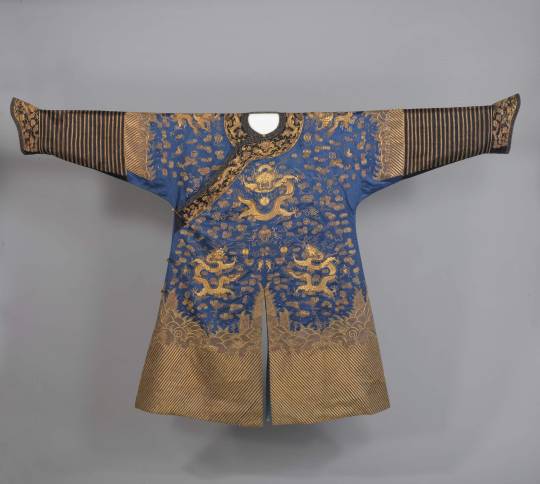


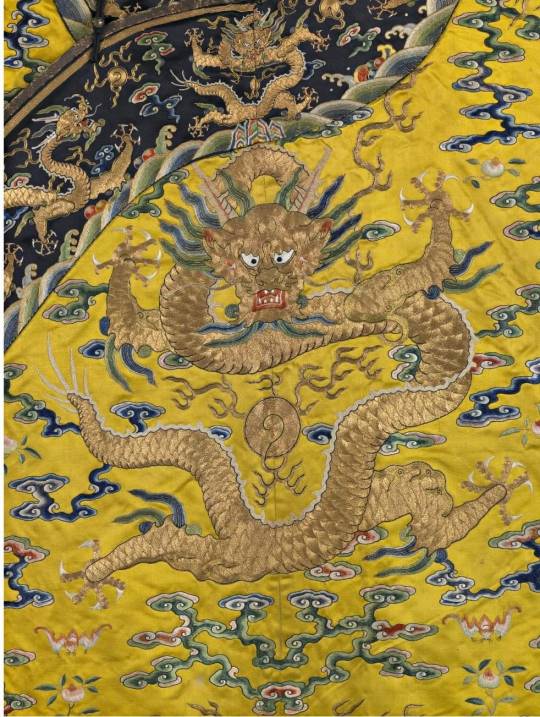

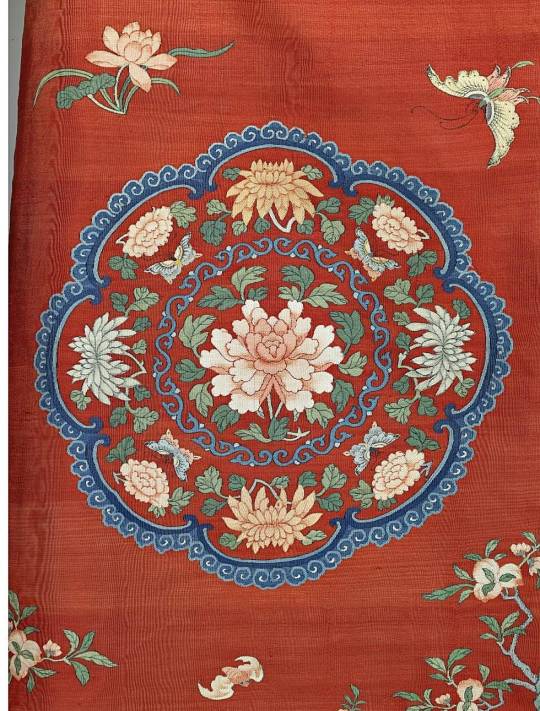

D'Artagnan.
Chinese robes from the St Louis Museum of Art. My favourite is #1 ❤❤❤
What amazes me apart from the beautiful embroidery and details is how these silks have been so well preserved considering their age ; particulalry #2 #3
#1 Red woman's jacket Qing dynasty, 1644–1911 late 19th century
Silk damask, applied embroidered satin borders, satin stitch, French knot, gold foil wrapped thread embroidery.© St Louis Museum Art
#2 Chinese Qing dynasty, 1644–1911 Yongzheng period, 1722–1735 early 18th century
Embroidered and brocaded silk with silk and metallic threads
This bright yellow satin robe is meticulously worked on the front and back with eight five-clawed dragons (long) pursuing flaming pearls, with a ninth dragon hidden on the front underflap. Auspicious bats fly over rolling waves and mountains.
The stylized stripes of deep water at the hem are finely embroidered in shades of green, blue, and white, with intervening gold threads. The undulating waves above them are satin-stitched with two or three colors mixed in any given band, producing a spectacular effect of shading. The slightly flared deep blue satin "horse-hoof" cuffs are decorated with dragons and multicoloured clouds above waves, as is the neck band. The garment's slits on front, back, and sides indicate an imperial rank of the highest order.
54 15/16 x 75 1/16 in. (139.5 x 190.7 cm)© St Louis Art Museum
#3 Chinese woman’s informal court robe Qing dynasty, 1644–1911
Qianlong period, 1736–1795
mid- to late 18th century
Silk tapestry (kesi) with metallic threads and pigments
length: 58 1/2 in. (148.6 cm)
This full-length robe has a front overflap fastened with four gilt metal ball-and-loop toggle buttons. The straight sleeves end in deep, slightly flared cuffs. The eight multicolored lobed floral medallions each contain a peony surrounded by other peonies, chrysanthemums, and butterflies. Scattered against the red silk ground are sprays of seasonal flowers. The turbulent waves at the bottom of the robe are rendered in the so-called "hurricane style." Rising from either side of the central mountain are traditional symbols of long life, indicating that the robe was worn to celebrate a significant birthday. The "Eight Precious Things" floating on the waves and the bats in flight are additional auspicious elements.© St Louis Museum Art
#4 Chinese Manchu blue robe
Qing dynasty, 1644–1911 Guangxu period, 1875–1908 late 19th century
Embroidered silk with silk and metallic threads
neck to hem: 53 9/16 in. (136 cm)
arm span: 88 3/16 in. (224 cm)
The body and upper sleeves of this court robe are decorated with nine five-clawed dragons, clouds, mountains, waves, all in gold against a blue ground. In the scattered scheme are the eight Buddhist emblems of good fortune, cloud scrolls, swastikas, and character medallions reading shou ("longevity"). The stylized "standing water" pattern is completely linear; the thin bands are characteristic of late-19th-century style. The tapered sleeves, in black twill with yellow ribbed pattern, end with flared "horse-hoof" cuffs. The neck band and cuffs have imperial imagery of dragons, waves with the "Eight Treasures," cloud scrolls, and bats against a black ground.© St Louis Museum Art
#5 and #6 details #4
#7 and #8 details #1
#9 Detail of #3
#10 Back of #1
Love D'Artagnan xxx".
4 notes
·
View notes